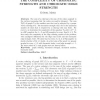28 search results - page 2 / 6 » Coloring the Cartesian sum of graphs |
DM
2008
13 years 5 months ago
2008
DAM
2010
13 years 5 months ago
2010
In the minimum sum edge coloring problem, we aim to assign natural numbers to edges of a graph, so that adjacent edges receive different numbers, and the sum of the numbers assign...
CC
2006
Springer
13 years 5 months ago
2006
Springer
The sum of a coloring is the sum of the colors assigned to the vertices (assuming that the colors are positive integers). The sum (G) of graph G is the smallest sum that can be ach...
DAM
2007
13 years 5 months ago
2007
The packing chromatic number χρ(G) of a graph G is the smallest integer k such that the vertex set of G can be partitioned into packings with pairwise different widths. Several...
DAM
2011
13 years 5 days ago
2011
In this paper, we study the Minimum Sum Set Coloring (MSSC) problem which consists in assigning a set of x(v) positive integers to each vertex v of a graph so that the intersectio...


